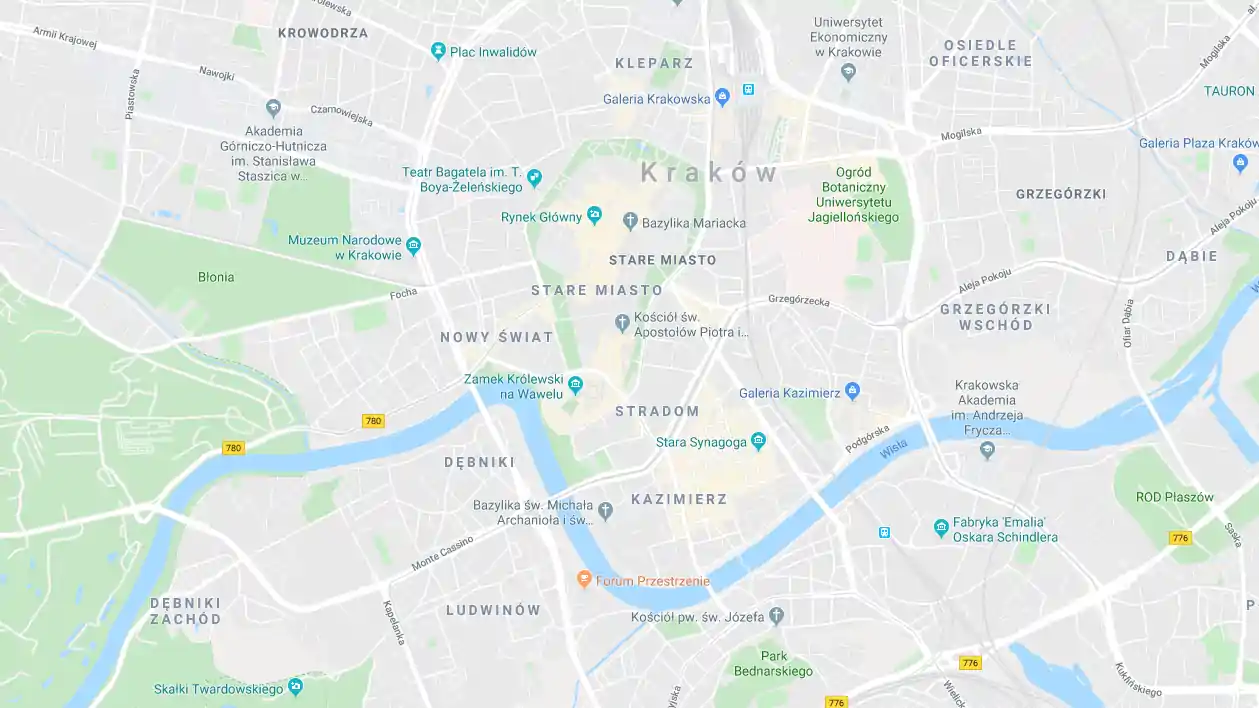Teatr im. Juliusza Słowackiego Kraków
pl. św. Ducha 1, 31-023 Kraków
Region turystyczny: Kraków i okolice
tel. +48 124244525
Teatr imienia Juliusza Słowackiego w Krakowie, otwarty jesienią 1893 roku jest jedną z najbardziej zasłużonych polskich scen dramatycznych. Decyzja o budowie była niezwykle kontrowersyjna, przedstawiono kilkanaście propozycji lokalizacji, ale ostatecznie by zyskać miejsce pod teatr, trzeba było wyburzyć średniowieczne zabudowania związane z najstarszym w Polsce szpitalem świętego Ducha. Nie obyło się bez skandalu. Słynny malarz Jan Matejko, który zaciekle walczył o pozostawienie w tym miejscu zabytków, na znak protestu zrezygnował z tytułu honorowego obywatela miasta Krakowa. Ale teatr stanął.
Budowany w latach 1891–1893 według projektu Jana Zawiejskiego nazywał się „Teatrem Miejskim” i miał nosić imię Aleksandra hrabiego Fredry. Ostatecznie w 1909 roku nadano teatrowi imię Juliusza Słowackiego w stulecie urodzin poety. Budynek teatru był wzorowany na operze paryskiej, na fasadzie widnieje motto: „Kraków narodowej sztuce”, a attyka reprezentacyjnej elewacji zachodniej wzorowana jest na attyce pobliskich Sukiennic i ozdobiona maszkaronami. Widownię teatru zdobi kurtyna Henryka Siemiradzkiego – malowidło olejne na płótnie przedstawiające scenę alegoryczną. Postaci wymalowane na kurtynie to Natchnienie, Piękno i Prawda, Tragedia, Komedia w towarzystwie błazna, Eros, Furie i Widma a także Psyche, Muzyka, Śpiew, i orszak bachiczny tańczący wokół pomnika Terpsychory. Po raz pierwszy kurtyna poszybowała w górę 10 kwietnia 1894 roku. Od 2018 roku Teatr posiada drugą ozdobną kurtynę opartą na szkicu Stanisława Wyspiańskiego pod tytułem „Z moich fantazyj” a wykonaną przez malarza Tadeusza Bystrzaka. Obok sceny mieści się zabytkowa garderoba Ludwika Solskiego, gdzie zobaczyć można rysunki i autografy artystów z XIX i XX wieku.
O wyjątkowej randze krakowskiej sceny zadecydował Stanisław Wyspiański. Ten najwybitniejszy polski artysta przełomu stuleci, poeta i malarz, genialny inscenizator obdarzony wizjonerską wyobraźnią, wystawił w Teatrze Miejskim większość swych dzieł. Legendarna prapremiera Wesela 16 marca 1901 roku – to jedno z najważniejszych wydarzeń w całej historii polskiej kultury. Ale "Słowacki" to także awangarda – prowokacyjne performanse i scena otwarta na młodych twórców. Teatrem kierowali wybitni dyrektorzy, między innymi Tadeusz Pawlikowski, Ludwik Solski, Juliusz Osterwa, Karol Frycz. Spektakle tworzyli tutaj znakomici artyści, reżyserzy tacy jak: Wilam Horzyca, Kazimierz Dejmek (reżyserzy), Andrzej Pronaszko, Tadeusz Kantor (scenografowie), a na scenie występowali najwięksi polscy aktorzy: Helena Modrzejewska, Irena Solska, Ludwik Solski, Juliusz Osterwa, Stefan Jaracz, Tadeusz Łomnicki, Gustaw Holoubek i wielu innych. To jedno z najważniejszych miejsc kultury i rozrywki w Polsce.
Teatr od lat zajmuje wyjątkowe miejsce w kulturze Krakowa. Na trzech scenach proponuje spektakle ważne, wartościowe, żywo komentujące współczesność, ale też w sposób twórczy odwołujące się do polskiej i europejskiej tradycji.
Duża Scena przy placu św. Ducha zarezerwowana jest na duże inscenizacje. Często są to propozycje opierające się na klasyce polskiej i światowej literatury albo artystyczne poszukiwania najważniejszych współczesnych polskich reżyserów.
Przy ul. Rajskiej 12 znajduje się Małopolski Ogród Sztuki, gdzie znajduje się Scena MOS – najbardziej progresywna i otwarta na eksperymenty scena teatru. W MOS działa także MOSkino, w którym grany jest repertuar Kina pod Baranami i gdzie Łukasz Maciejewski prowadzi cykl „Przywrócone arcydzieła” z udziałem gwiazd polskiego kina. W Małopolskim Ogrodzie Sztuki odbywają się także spotkania teatralno-filozoficzne „Myślnik”, koncerty, warsztaty i wernisaże.
Nowym życiem został obdarzony Dom Machin (któremu przywrócono pierwotną nazwę, dawniej Scena Miniatura). To miejsce na humor, małe formy teatralne, debiuty, czy inicjatywy artystyczne aktorów teatru.
